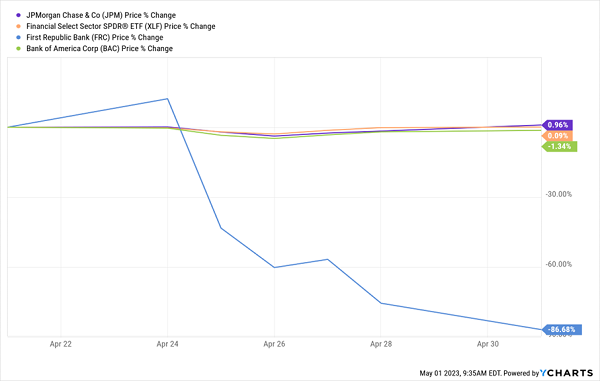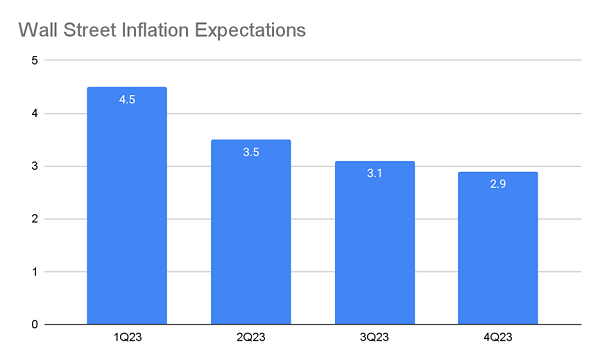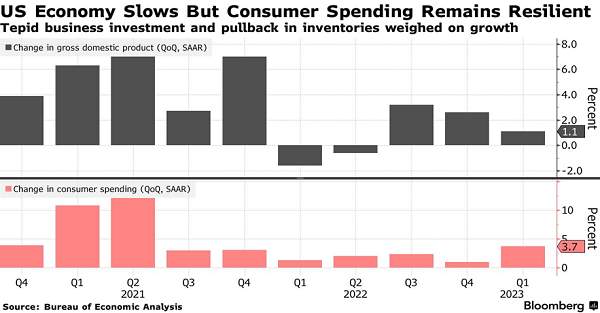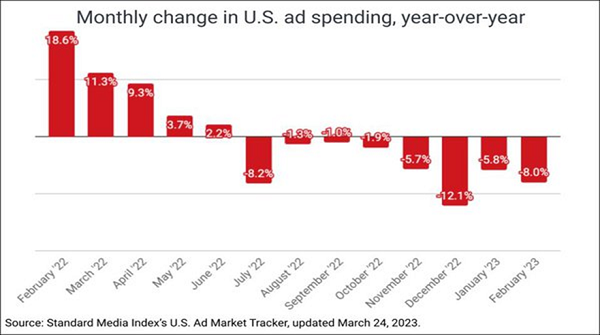We’ve written before about the big disconnect between the rising stock market and (ridiculously!) negative media coverage we’ve seen over the last 16 months. Well, the media is at it again, this time with the whole First Republic Bank (FRC) fiasco.
And we contrarians are going to keep using overtorqued coverage as our guide to grabbing big discounts and steady dividends in closed-end funds (CEFs) and other assets.
Before we go too far, there are a couple things we need to keep in mind with this FRC mess: first, as was the case with other troubled banks, including SVB and Credit Suisse, a buyer (or the government) swooped in and managed the problem. This time JPMorgan Chase & Co. (JPM) was the suitor, buying up FRC last Sunday.
Second, FRC isn’t really a bank in the traditional sense; it mainly makes money by offering commercial loans and mortgages to business owners. Third, it’s less than a tenth the size of big banks like Goldman Sachs (GS), Bank of America (BAC) and JPM.
All of this is why the banking sector and its investors have simply soldiered on during these last couple of weeks. We can see that in the steady performances of the benchmark Financial Select Sector SPDR ETF (XLF), in orange below, as well as JPM (in purple) and BAC (in green), as of this writing, compared to the swan dive in FRC stock (in blue)
FRC Fails, Banking Sector Shrugs

This chart is a major clue that the media is drastically out of step with reality. And it’s one we can extend beyond the banking crisis to the economy as a whole. Because despite ongoing media predictions of a recession, the stock market has stabilized: the S&P 500 is up nearly 9% since January 1, as of this writing. That’s more than it typically gains in a year—in just over four months!
Partly, of course, this is a result of sheer exhaustion with alarmist news coverage. But there’s something else going on: retail investors might actually be focusing more on the data than the financial media is. And the data is, well, pretty positive.
Inflation Coming Down

While inflation remains elevated, with the consumer price index coming in at 5% for March, it’s also dropped nearly in half from its 8.9% peak in the summer of 2022. It’s now fallen to May 2021 levels and is on course to head lower. The current Wall Street consensus is for inflation to fall to 2.8% by the end of this year. Right where it was in 2018, in other words.

Source: Philadelphia Federal Reserve, CEF Insider
And then there’s the growth story, which is also strong, despite worries that the Fed will overtighten and tip us into that recession everyone’s been talking about.

While it’s true that US GDP growth fell to 1.1% in the first quarter, down from 2.6% in the fourth, we’re still far from the two quarters of contraction we saw in mid-2022. It’s also important to note that the first-quarter GDP data is the first advance estimate, and these are often revised upward.
Plus, the quarter-over-quarter GDP decline was largely because of companies and governments spending less, not consumers; spending rose 2.3% on services and 6.5% on goods in the first quarter. These are not recession numbers! Which is why the Bureau of Economic Analysis highlighted consumer spending as one of the biggest economic-growth drivers at the start of 2023.
So why aren’t we getting this angle from the coverage we’re all reading every day? I’d argue it’s because the media itself is in contraction, and the folks who write for the business press can’t help but be influenced by that. As we can see below, advertising spending has been in decline for nearly a year now, and the media sector has been shedding jobs as a result.

Where does all of this leave us? Until the S&P 500 achieves its high from the end of 2021, we have plenty more upside to go in the stock market.
5 Critical Buys for 20%+ Gains (and Steady 9% Dividends)
With the S&P 500 still short of its 2021 highs, our opportunity is very much alive here. And we also have a unique opportunity to match the market’s year-to-date gain in dividends alone with the 5 CEFs I’m urging investors to buy today.
These 5 income plays yield 9% now and pay you every single month, too! And thanks to their deep discounts, I’m forecasting 20%+ average price gains in the next year.
Click here and I’ll tell you more about these 5 “fire sale” monthly payers and give you the opportunity to download a free Special Report revealing their names, tickers, yields, discounts, current holdings and my latest analysis of each one.

Recent Comments